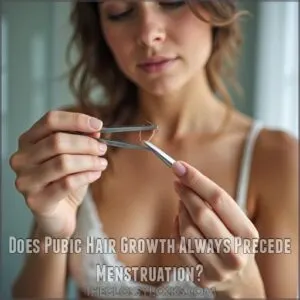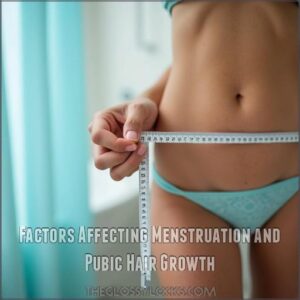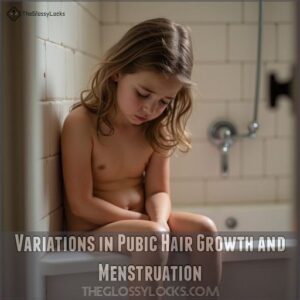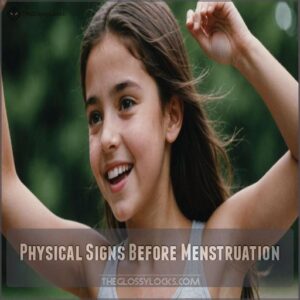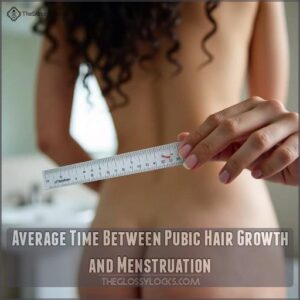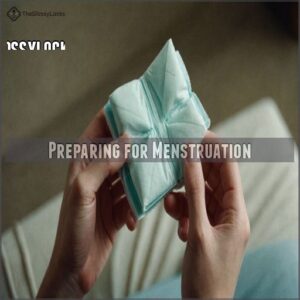This site is supported by our readers. We may earn a commission, at no cost to you, if you purchase through links.
 Wondering how long after hair growth does your period start?
Wondering how long after hair growth does your period start?
Typically, your first period arrives about two years after you notice pubic hair or breast development begins.
This timing can vary widely, though, because every body’s clock ticks a little differently.
You might find it reassuring to know you’re not alone if yours doesn’t fit neatly into the average timeframe.
Body changes like armpit hair, a growth spurt, or breast buds suggest that menstruation isn’t too far off.
Curious about how to prepare for these changes?
There are some simple tips and tricks that can help make this time easier.
Table Of Contents
- Key Takeaways
- Pubic Hair Development Starts
- Relationship to Menstruation
- Physical Signs Before Menstruation
- Average Time Between Pubic Hair Growth and Menstruation
- Preparing for Menstruation
- Frequently Asked Questions (FAQs)
- How long does hair grow?
- When does hair grow in a boy & a girl?
- How long does a hair growth cycle last?
- When does pubic hair development start?
- How soon after hair growth does period start?
- What comes first, periods or pubic hair?
- How can I tell if my daughter is about to start her period?
- How long after getting armpit hair does your period start?
- What causes irregular periods in teenagers?
- How does nutrition affect menstrual cycles?
- Can stress delay the start of periods?
- Are there early signs of first menstruation?
- How to manage menstrual cramps effectively?
- Conclusion
Key Takeaways
- You typically start your period about two years after noticing pubic hair or breast development, but this timeline can vary widely.
- Puberty changes, like armpit hair and a growth spurt, often indicate that menstruation isn’t far off, so stay prepared for these signs.
- Each girl’s body follows its own unique schedule, so don’t stress if your period doesn’t align with your peers.
- Nutrition, lifestyle, and stress levels influence the timing of your period, highlighting the importance of a balanced diet and managing stress.
Pubic Hair Development Starts
You’ll notice pubic hair growth as one of the first signs of puberty, typically starting between ages 8 and 13.
This development marks the beginning of physical changes in your body.
Often preceding other puberty milestones like menstruation.
Early Signs of Pubic Hair Growth
The journey of puberty begins with subtle changes.
You might notice fine, soft hair appearing in your pubic area.
This early pubic hair growth is often lighter in color and texture than adult hair.
As this new hair grows, you should take care of the area, using gentle methods such as Shaving Cream Application for a smooth, comfortable experience.
It’s perfectly normal and a sign your body’s gearing up for big changes.
As puberty progresses, the hair becomes coarser and darker.
Remember, everyone’s puberty timeline is unique, so don’t worry if your experience differs from your friends’.
Tanner Stages and Pubic Hair
Puberty’s journey unfolds through Tanner stages, with pubic hair development playing a key role.
During this time, you can find products catering to your needs at Puberty Hair Solutions.
You’ll notice fine, straight hair appearing on your pubic area in Stage 2.
As you progress to Stage 3, this hair becomes darker and curlier.
By Stage 4, pubic hair resembles adult hair but covers a smaller area.
Average Age for Pubic Hair Growth
Pubic hair growth typically kicks off between ages 8 and 13 for girls, marking an early sign of puberty.
This timeline can vary due to genetic influence and ethnic differences.
Remember, everyone’s body follows its own schedule.
Key points to keep in mind:
- Individual variations are normal
- Puberty timing differs for everyone
- Pubic hair growth usually precedes your first period
Don’t worry if you’re early or late to the party.
Your body’s on its own unique journey through puberty.
Relationship to Menstruation
You might wonder if pubic hair growth always comes before your first period.
While pubic hair often appears first, the relationship between hair growth and menstruation can vary, influenced by factors like genetics and overall health.
Does Pubic Hair Growth Always Precede Menstruation?
While pubic hair growth often precedes menstruation, it’s not a hard and fast rule.
Your body’s unique timeline might surprise you.
Some girls experience their first period before noticeable hair growth, while others wait months after hair appears.
Puberty milestones can be as unpredictable as a rollercoaster ride.
Remember, there’s no "right" order – your body’s just following its own rhythm.
Embrace the journey, and don’t sweat the small stuff.
Factors Affecting Menstruation and Pubic Hair Growth
Several factors influence the timing of menstruation and pubic hair growth.
Your body’s unique blueprint determines when these puberty signs appear.
Hormonal influences play a key role, while genetics set the stage for your development timeline, including why some people may experience faster hair growth patterns.
Consider these factors:
- Nutrition: A balanced diet supports healthy growth
- Lifestyle choices: Exercise and sleep patterns affect hormones
- Stress levels: High stress can delay menstruation
- Environmental factors: Certain chemicals may affect puberty onset
Understanding these influences empowers you to navigate this natural change with confidence.
Variations in Pubic Hair Growth and Menstruation
Individual variation plays a big role in pubic hair growth and menstruation.
Your genetics, ethnic background, and hormonal factors all influence when these changes occur.
Some girls might sprout underarm hair before their first period, while others experience breast growth first.
Age isn’t a one-size-fits-all marker either.
Remember, your body’s unique timeline is perfectly normal.
Puberty signs like hair growth and period timing can vary widely, so don’t stress if you’re not following the textbook order.
Physical Signs Before Menstruation
Your body provides several clues that your first period is approaching. These physical signs include breast development, the growth of armpit hair, and a noticeable growth spurt.
Breast Development and Menstruation
Before your first period, you’ll notice breast changes.
These developments signal your body’s preparation for menstruation.
Here’s what to expect:
- Breast buds form
- Areolas expand
- Breasts become tender
- Full breast shape develops
Typically, breasts start growing about two years before your period begins.
Your breast size may fluctuate during your menstrual cycle due to hormonal changes.
Remember, everyone’s body is unique, so don’t worry if your timeline differs slightly.
Armpit Hair and Menstruation
While breast development often takes center stage, armpit hair growth is another key sign of approaching menstruation.
You’ll typically notice this hair sprouting around age 11-12, shortly after pubic hair appears.
For those looking to manage their armpit hair during this time, consider exploring products for your Armpit Hair Period Needs.
It’s a normal part of puberty, signaling hormonal changes in your body.
Remember, everyone’s timeline is different.
Some girls may get their period before armpit hair grows, while others might wait a bit longer.
Growth Spurt and Menstruation
Growth spurts often coincide with the onset of menstruation.
You’ll likely experience a rapid increase in height during puberty, typically peaking about a year before your first period.
This growth spurt can start as early as age 8 or as late as 13.
Your body’s changing shape, including widening hips, may also signal that your period is approaching.
Remember, everyone’s timeline is unique, so don’t worry if yours differs from your friends’.
Average Time Between Pubic Hair Growth and Menstruation
You’re probably wondering how long after pubic hair growth your period will start.
Typically, menstruation begins about two years after the first appearance of pubic hair, but this timeline can vary from person to person.
Variations in Time Between Pubic Hair Growth and Menstruation
The timing between pubic hair growth and your first period can be as unique as you are.
On average, you’ll experience your first menstrual cycle about two years after pubic hair appears.
However, this timeline isn’t set in stone.
Some girls may start their periods just months after noticing pubic hair, while others might wait up to three years.
Remember, everyone’s body follows its own schedule, so don’t worry if yours seems different from your friends’.
Factors Affecting Time Between Pubic Hair Growth and Menstruation
Let’s explore what influences the time between pubic hair growth and your first period.
These factors can make your body’s timeline unique:
- Your genes play a starring role in this biological drama
- Nutrition fuels your body’s changes, like adding logs to a fire
- Stress can throw a wrench in your hormonal gears
- Your overall lifestyle acts as the director of your puberty story
Remember, everyone’s path is different.
Your body’s timing is as unique as your fingerprint.
Average Age for First Menstruation
On average, girls experience their first period around age 12, though it can occur between 10 and 15.
Factors like genetics, nutrition, and overall health influence the timing.
Here’s a breakdown of menstruation onset:
| Age Range | Percentage | Notes |
|---|---|---|
| 10-11 | 20% | Early |
| 12-13 | 60% | Average |
| 14-15 | 15% | Late |
| [10 or ]15 | 5% | Consult doctor |
Remember, every girl’s body follows its own timeline.
If you’re concerned about your development, talk to a healthcare provider.
Preparing for Menstruation
As you get closer to your first period, you’ll notice signals like breast development and the appearance of pubic hair.
Preparing for this change means understanding these signs and ensuring you’re ready with the necessary menstrual products and knowledge for a smooth experience.
Signs of Approaching Menstruation
Spotting signs of approaching menstruation can seem like decoding nature’s clues.
You’ll notice acne making an appearance and maybe some bloating tagging along.
Mood swings and cramps often join the pre-period party too.
Don’t be surprised by spotting or sudden changes in your hair’s growth pattern either—adhering to certain hairstyles like braiding for hair protection can also influence this—it’s all part of the hair growth period changes on this biological journey.
Tips for Preparing for Menstruation
As you notice the signs of menstruation approaching, it’s time to prepare.
Understanding your cycle helps manage those period mood swings.
Embrace period hygiene habits to stay fresh and confident.
Useful tips include:
- Track your cycle with period tracker apps.
- Manage menstrual cramps with exercise and a warm bath.
- Stay hydrated and eat a balanced diet.
- Keep emergency supplies at hand.
Menstrual Products and Concerns
With periods approaching, you’ll need menstrual products.
Choosing the right one is key to comfort and confidence.
Let’s explore your options!
| Period Product Type | Advantages | Disadvantages |
|---|---|---|
| Pads | Easy to use, readily available | Can be bulky, less discreet |
| Tampons | Discreet, allows for activity | Requires proper insertion, TSS risk |
| Menstrual Cup | Reusable, eco-friendly | Requires learning curve, potential leakage |
| Period Underwear | Comfortable, leak-proof | Can be expensive, requires washing |
Remember safe disposal practices for all products.
Frequently Asked Questions (FAQs)
How long does hair grow?
Like a clock’s steady tick, hair typically grows about half an inch per month, amounting to roughly 6 inches a year.
Hair growth is influenced by several factors, including genetics and nutrition.
Keep those stress levels in check!
When does hair grow in a boy & a girl?
Hair growth in a boy and girl mainly occurs during puberty.
For girls, it starts around 9 to 11 years, with breast and pubic hair development.
For boys, it begins around age 11, with early pubic hair appearance.
How long does a hair growth cycle last?
The hair growth cycle spans several phases.
Anagen, the active growth phase, lasts 3-5 years.
Catagen is a brief intermediary phase of 10 days, while Telogen and Exogen, resting and shedding phases, last roughly 3-5 months.
When does pubic hair development start?
Did you know puberty often kicks off with pubic hair growth around ages 9 to 11 for girls and 11 for boys?
This signals the start of Tanner Stage 2, as your body begins its transformative journey.
How soon after hair growth does period start?
Periods usually begin around two years after breast growth starts, often alongside pubic and underarm hair development. It’s a unique timeline for everyone, so don’t worry if it varies.
What comes first, periods or pubic hair?
You might notice pubic hair growing before your first period.
Puberty generally starts with breast development and pubic hair growth, usually preceding menstruation by about two years.
This timing varies, so individual experiences may differ.
How can I tell if my daughter is about to start her period?
Notice some tell-tale signs to predict the big day.
When underarm and pubic hair appear and breast development progresses, your daughter might soon start her period.
This typically occurs about two years after initial breast growth begins.
How long after getting armpit hair does your period start?
Typically, after armpit hair starts growing, a girl’s first period may occur within a few months to a couple of years.
This range varies widely as individual development differs, often beginning about two years after breast growth starts.
What causes irregular periods in teenagers?
Hormonal changes, stress, and weight fluctuations can lead to irregular periods in teenagers.
Stress, diet, and excessive exercise often play roles, while conditions like polycystic ovary syndrome may also contribute.
Consult a healthcare provider if you’re concerned.
How does nutrition affect menstrual cycles?
Good nutrition supports regular menstrual cycles by maintaining hormonal balance.
Eat a variety of iron-rich foods, vitamins, and healthy fats to help your body produce hormones steadily and help your cycles remain as predictable as possible.
Can stress delay the start of periods?
Yes, stress can delay the onset of periods.
When you’re stressed, your body produces cortisol, which can disrupt hormone levels responsible for menstruation.
Finding effective stress management techniques may help regulate your menstrual cycle.
Are there early signs of first menstruation?
Your body’s preparing for a big change!
Look out for breast development and pubic hair growth; these often precede your first period by a couple of years.
It’s perfectly normal if it varies.
How to manage menstrual cramps effectively?
To manage menstrual cramps, try applying heat to your abdomen, practicing relaxation techniques, and staying hydrated.
Over-the-counter pain relievers like ibuprofen can help too.
Regular exercise and a balanced diet may reduce cramp intensity over time.
Conclusion
About 50% of girls get their first period within two years of starting pubic hair development.
Remember, how long after hair growth your period starts can vary.
Pubic hair and breast development are just parts of your body’s unique timeline.
If you’re noticing changes, like a growth spurt or armpit hair, it might be time to get ready for menstruation.
Understanding these signs helps you prepare, ensuring you have what you need when the time comes.




